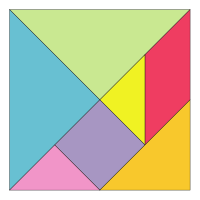Tangram
| Tangram | |
|---|---|
 Tangram |
|
| Game data | |
| publishing company | several |
| Publishing year | historical game |
| Art | Placement game |
| Teammates | 1 |
| Duration | depending on ability |
| Age | from age 6 |
Tangram (also Siebenbrett or Siebenschlau or Chinese 七巧板 , Pinyin qī qiǎo bǎn ) is an old Chinese placement game that was probably made between the 8th and 4th centuries BC. BC originated. The western name of the puzzle seems to be a made-up word that may resonate with the Chinese Tang Dynasty .
history
After the first template books were printed in China at the beginning of the 19th century, the game Tangram found its way into Europe and America around 1813 . In the German-speaking countries, the then famous factory F. Ad. Richter and Cie. , kuk court purveyors Rudolstadt, Nuremberg, Vienna, Olten, Rotterdam, New York the clientele with a pocket edition for the price of 20 pfennigs. This appeared in several editions under the title Kopfzerbrecher . The success compelled the publisher to play other games of a similar nature, which then appeared under Quälgeist and Kreuzzerbrecher . In 1892 the Danish teacher Sophus Tromholt brought out other mathematical laying games based on tangram, which became known under the names Nutcracker and Yum Yum .
The game experienced a renaissance in the mid-1970s when DuMont- Verlag published a combined book-game as a paperback edition in bilingual German / Dutch in which around 1,600 templates are listed.
Legend
According to legend, a monk once commissioned his disciple to travel to paint the essence of the world's diverse beauty on just one ceramic tablet. Unfortunately, the board broke into seven separate pieces and the student could no longer fold it into a square.
He tried for days. An infinite number of patterns and images were created.
In the end, the student understood: He doesn't have to travel out into the world. He can easily find the beauty and diversity of the world in the seven parts of the broken tablet.
Game material
The game consists of seven tiles in simple geometric shapes. The platelets are created by "cutting" a square into two large triangles , a medium-sized triangle, two small triangles, a square and a parallelogram .
Countless shapes can be laid out of these tiles, which then show animals, ships or other shapes like a silhouette . Usually all parts have to be used for this, whereby they must not be placed on top of one another.
variants
There are variations, such as the magic egg (or egg of Columbus / wonder) and the heart puzzle , which are based on other basic forms. Numerous other variants have also appeared in the form of circles and rectangles.
See also
- Ostomachion (Loculus Archimedicus) - a game in ancient times that was found among the Greeks and Romans .
- Three triangles tangram
- Bunny Game (Puzzle) (Question du Lapin)
- T-puzzle
- Soma tangram with the soma cube
literature
- Erwin Glonnegger : The game book: board and placement games from all over the world; Origin, rules and history . Uehlfeld: Drei-Magier-Verlag, 1999. ISBN 3-9806792-0-9
- Daniel Picon: Tangram. Play - think - learn. More than 1000 tasks and solutions ; 2004; ISBN 3-89717-277-1
- Joost Elffers: Tangram. The old Chinese game of forms - Het oude Chinese vormenspel . DuMont Buchverlag Cologne. 1978; ISBN 3-7701-0899-X
Web links
- Page about tangrams
- Tangram in Flash
Individual evidence
- ↑ Magic Egg. Retrieved November 21, 2019 .

